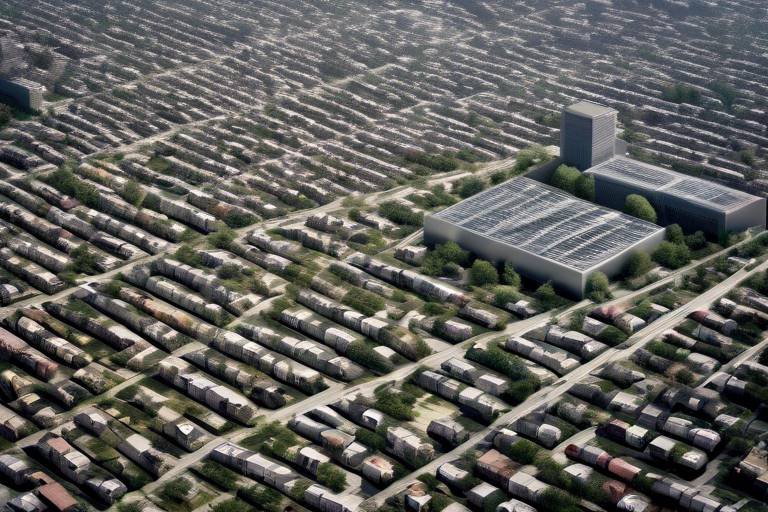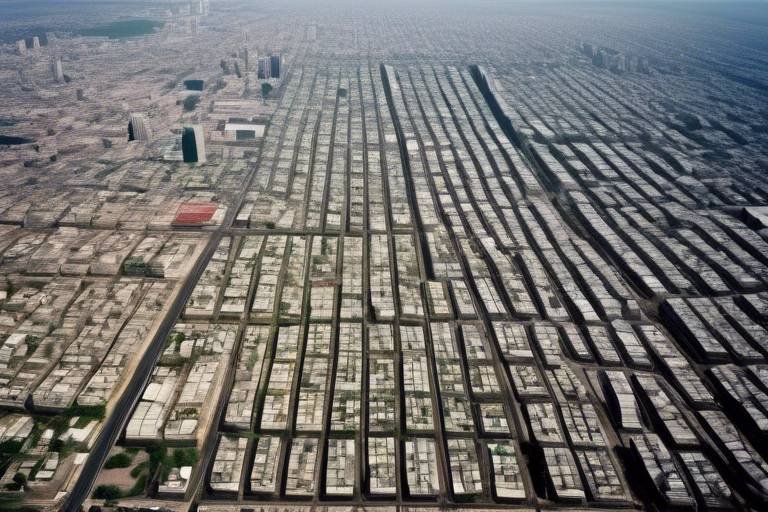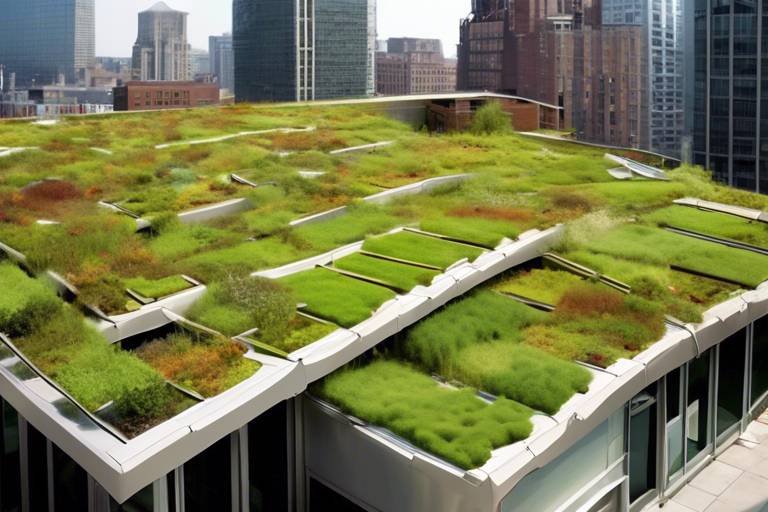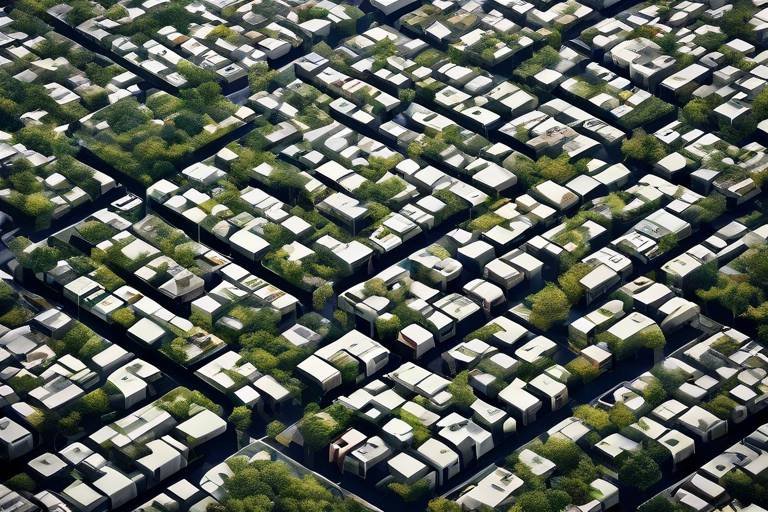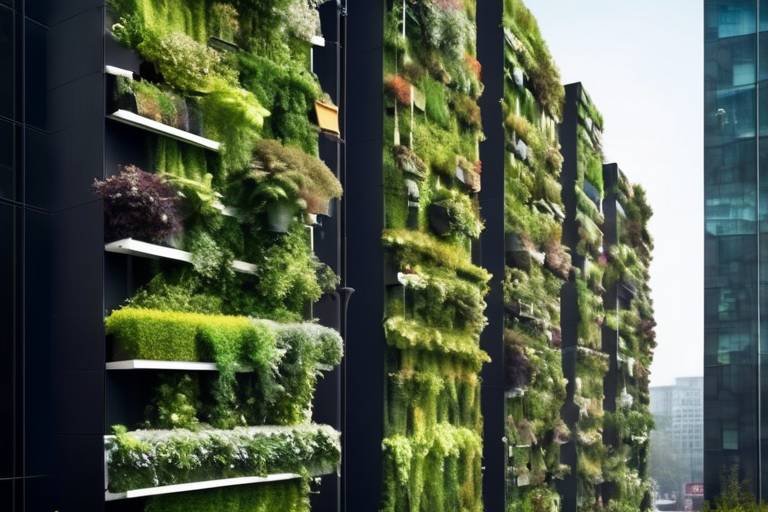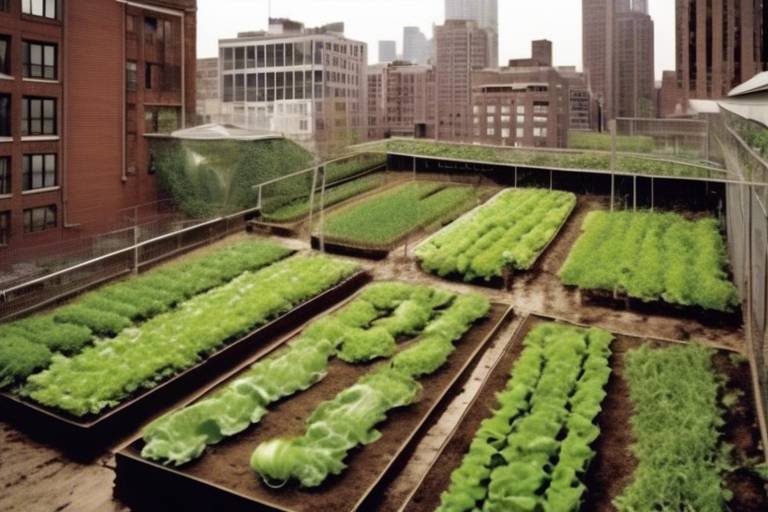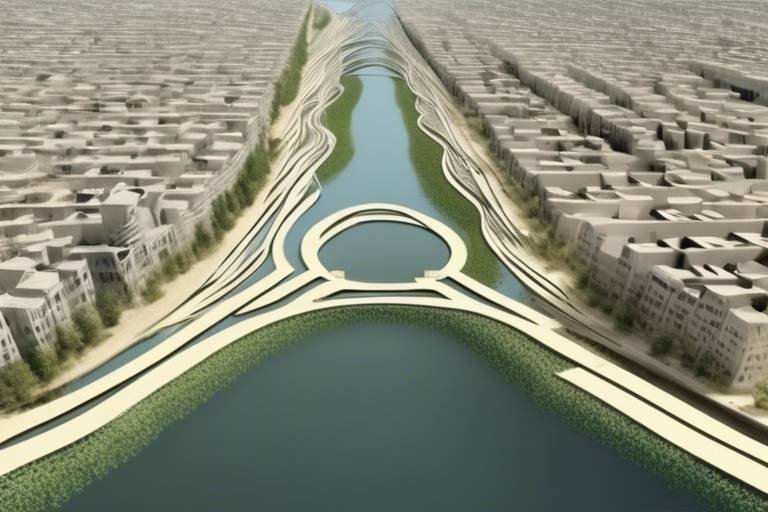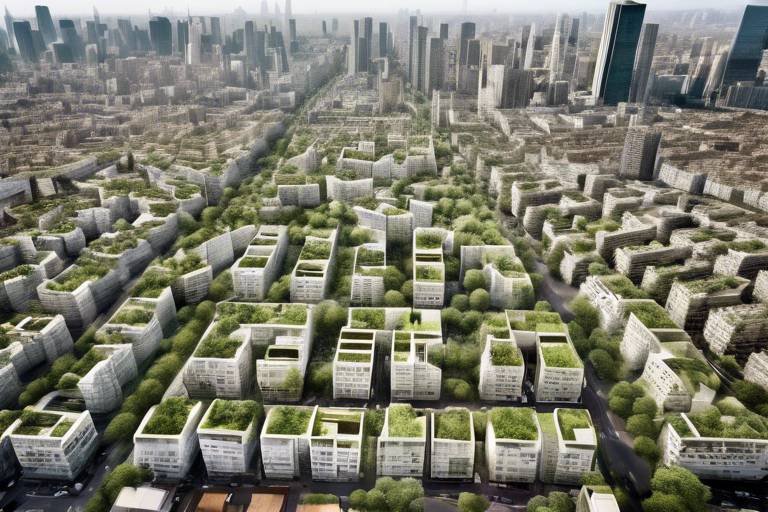Redefining Urban Living: Are Capsule Homes Sustainable?
In an era where urban spaces are becoming increasingly congested, the concept of capsule homes has emerged as a potential game changer. But what exactly are capsule homes, and how do they fit into the sustainability narrative? These compact living spaces are designed not just to maximize efficiency but also to minimize land use, making them an appealing option for city dwellers looking for innovative solutions to housing challenges. Imagine living in a space that feels like a cozy cocoon, yet provides all the essentials you need—this is the essence of capsule living.
Capsule homes originated from the need for affordable and efficient housing, particularly in densely populated areas. They typically feature modular designs, allowing for quick assembly and disassembly, which is ideal for urban settings where space is at a premium. With their sleek, modern aesthetics, these homes challenge traditional notions of what a dwelling should be. They are often equipped with multifunctional furniture and smart storage solutions, making every square inch count. But while they may look futuristic, the real question is whether they can genuinely contribute to sustainable urban living.
Capsule homes are not just about aesthetics; they represent a shift in how we think about urban living. By focusing on compactness, these homes encourage a lifestyle that prioritizes minimalism and efficiency. With their origins rooted in Japan's capsule hotels, they have evolved into full-fledged residences that cater to the needs of modern urbanites. The design principles behind capsule homes emphasize functionality, sustainability, and a sense of community, making them a viable option for those seeking alternatives to traditional housing.
One of the most compelling arguments for capsule homes lies in their potential to reduce our ecological footprint. These homes are designed to be energy-efficient, utilizing less power for heating and cooling compared to conventional houses. Imagine a world where your home not only provides shelter but also contributes to a healthier planet. By minimizing waste and energy consumption, capsule homes align perfectly with the growing movement toward sustainable living.
The sustainability of capsule homes is significantly influenced by the materials used in their construction. Eco-friendly materials not only lower the environmental impact but also enhance the overall living experience. For instance, many capsule homes incorporate recycled materials, which help to reduce waste and promote a circular economy. By choosing sustainable resources, builders can create homes that are not just livable but also environmentally responsible.
Utilizing recycled materials in the construction of capsule homes is a fantastic way to promote sustainability. Materials such as reclaimed wood, recycled metal, and repurposed glass can be used to create unique and stylish living spaces. This approach not only reduces the demand for new resources but also minimizes waste in landfills. Imagine stepping into your home and knowing that every element has been thoughtfully sourced to protect the planet.
Incorporating energy-efficient technologies is crucial for the sustainability of capsule homes. From solar panels to energy-efficient appliances, these innovations can significantly reduce energy consumption and lower utility bills. For example, many capsule homes are designed with large windows that maximize natural light, reducing the need for artificial lighting during the day. The integration of smart home technologies can also optimize energy use, making it easier for residents to manage their consumption.
While capsule homes offer environmental benefits, they also raise important social questions. How do these compact living spaces affect community dynamics? As urban populations grow, the need for affordable housing becomes more pressing. Capsule homes can provide a solution, but they must be integrated thoughtfully into the urban fabric to foster a sense of community. It’s essential to consider how these homes will interact with existing neighborhoods and contribute to the overall quality of urban life.
Capsule homes have the potential to be a game changer in terms of affordability. With rising housing costs in urban areas, these compact dwellings could provide a viable option for low-income families and individuals. The affordability of capsule homes can help alleviate some of the pressure on housing markets, making it easier for people to find suitable living arrangements. However, for this potential to be realized, supportive housing policies must be in place.
Government policies play a vital role in promoting sustainable housing solutions like capsule homes. Various initiatives, such as tax incentives for builders and subsidies for low-income residents, can encourage the development of these innovative living spaces. By creating a favorable regulatory environment, governments can help facilitate the growth of capsule homes in urban areas, ensuring that they are accessible to those who need them most.
Engaging communities in the design and development of capsule homes is essential for creating livable urban environments. Community input can help shape the features and amenities that residents value most, ensuring that these homes meet the needs of the people who will live in them. By fostering a sense of ownership and involvement, communities can create vibrant, sustainable neighborhoods that thrive.
As we look to the future, capsule homes present exciting possibilities for urban living. They challenge traditional housing norms and offer innovative solutions to some of the most pressing issues facing cities today. However, the journey toward widespread adoption will not be without its challenges. It will require collaboration between governments, builders, and communities to ensure that these homes can thrive in urban landscapes.
- What are capsule homes? Capsule homes are compact living spaces designed to maximize efficiency and minimize land use, often featuring modular designs.
- Are capsule homes environmentally friendly? Yes, they can significantly reduce waste and energy consumption, making them a sustainable option for urban living.
- How do capsule homes affect community dynamics? They can provide affordable housing solutions but must be integrated thoughtfully to foster community interaction.
- What materials are used in capsule homes? Eco-friendly and recycled materials are often used to minimize environmental impact.
- What role do government policies play? Government initiatives can support the development of capsule homes through incentives and subsidies.

Understanding Capsule Homes
Capsule homes are a revolutionary concept in urban living, designed to offer a compact yet functional space for individuals and families. Imagine a cozy nook that has everything you need—kitchen, bathroom, and sleeping area—all within a few square meters. This innovative approach to housing originated in Japan during the 1970s, where space was at a premium, and the need for efficient living solutions became paramount. Over time, the idea has evolved, gaining traction in cities around the world as urban populations continue to swell.
At their core, capsule homes are characterized by their minimalist design and efficient use of space. These homes often feature modular layouts that can be customized according to the occupant's needs, making them not just a place to live, but a reflection of personal style. The essence of capsule living is to maximize functionality while minimizing clutter, which is a breath of fresh air in our often chaotic urban environments.
But what exactly makes capsule homes a viable solution for modern cities? The answer lies in their ability to address several pressing issues:
- Space Efficiency: Capsule homes utilize vertical space and multifunctional furniture, allowing residents to live comfortably in small areas.
- Affordability: With lower construction costs and reduced land use, capsule homes can offer a more affordable housing option for those in urban settings.
- Environmental Benefits: Their compact nature often leads to reduced energy consumption and waste, aligning with sustainable living principles.
In many ways, capsule homes represent a shift in how we think about space and community. They challenge the traditional notion of home ownership and encourage a more communal lifestyle, where shared amenities and public spaces become integral to daily life. This shift can foster a sense of community among residents, as they navigate the challenges of urban living together.
Moreover, the design principles behind capsule homes emphasize flexibility and adaptability. Many of these structures can be easily relocated or repurposed, making them ideal for urban environments that are constantly changing. The ability to adjust to the evolving needs of a city is crucial in our fast-paced world, where the only constant is change.
As we delve deeper into the characteristics and benefits of capsule homes, it's essential to recognize their potential impact on urban living. These homes are not just a trend; they are a response to the realities of modern life, offering a glimpse into a future where sustainable, affordable, and community-focused living is within reach for everyone.

Environmental Impact
When we think about urban living, one of the first things that come to mind is the sheer environmental burden that cities impose on our planet. From towering skyscrapers to sprawling suburbs, traditional housing often leads to significant waste and energy consumption. Enter capsule homes, a revolutionary concept that promises to change the narrative. These compact living spaces are designed not just for efficiency but also with a keen eye on sustainability, making them a beacon of hope for environmentally conscious urban dwellers.
Capsule homes are built with a focus on reducing their ecological footprint. By utilizing less land and fewer resources, these homes can significantly lower waste generation and energy consumption. Imagine living in a space that not only meets your needs but also helps in conserving our planet's precious resources. With the right design and materials, capsule homes can minimize carbon emissions, making them an attractive option for those who want to live sustainably without sacrificing comfort.
The choice of materials in capsule home construction plays a pivotal role in their overall sustainability. Eco-friendly materials such as bamboo, recycled steel, and reclaimed wood are increasingly being used to create these innovative living spaces. By opting for these materials, builders can reduce the demand for new resources, effectively lowering the environmental impact of construction. Not only do these materials boast durability, but they also contribute to a healthier living environment.
Utilizing recycled materials in construction can significantly reduce waste and promote sustainability. For instance, many capsule homes incorporate materials like recycled plastics and repurposed bricks. These options not only help in minimizing landfill waste but also provide unique aesthetic qualities to the homes. Imagine walking into a space that tells a story of sustainability and innovation—each recycled component is a testament to a commitment to the environment.
Incorporating energy-efficient technologies is crucial for sustainability in capsule homes. From solar panels to energy-efficient appliances, these technologies are designed to optimize energy use and reduce costs. For example, many capsule homes are equipped with smart home systems that monitor energy consumption in real-time, allowing residents to adjust their usage accordingly. This not only leads to lower utility bills but also contributes to a significant reduction in overall energy demand.
Moreover, the integration of green roofs and rainwater harvesting systems can further enhance the sustainability of these homes. Green roofs not only provide insulation but also promote biodiversity by creating habitats for various species. Meanwhile, rainwater harvesting systems can reduce dependency on municipal water supplies, showcasing how capsule homes can lead to a more sustainable urban lifestyle.
While capsule homes address many environmental concerns, they also raise important social questions. How do these compact living spaces impact community dynamics? As cities continue to grow, the need for sustainable housing solutions becomes more urgent. Capsule homes can foster a sense of community by encouraging shared spaces and resources, ultimately leading to a more connected urban experience. However, it’s essential to consider how these homes fit into the existing urban fabric and whether they can enhance the quality of life for residents.
In conclusion, the environmental impact of capsule homes cannot be overstated. They offer a sustainable alternative to traditional housing, making them an ideal choice for urban dwellers who are eager to reduce their ecological footprint. As we move toward a future where sustainability is paramount, capsule homes stand out as a viable solution that harmonizes with both our living needs and the health of our planet.
- What are capsule homes? Capsule homes are compact living spaces designed to maximize efficiency and minimize land use, often incorporating sustainable materials and technologies.
- How do capsule homes reduce environmental impact? They minimize waste, energy consumption, and carbon emissions through their design and the use of eco-friendly materials.
- What materials are commonly used in capsule homes? Common materials include recycled plastics, reclaimed wood, and bamboo, which help reduce the demand for new resources.
- Can capsule homes support community living? Yes, they can foster community dynamics by encouraging shared spaces and resources, enhancing the urban living experience.

Materials and Resources
When it comes to capsule homes, the choice of materials is pivotal in shaping their sustainability. These innovative living spaces are not just about compactness; they also emphasize the importance of using resources wisely. Imagine living in a home that not only serves your needs but also respects the planet. This is where sustainable materials come into play, transforming the way we think about housing in urban settings.
One of the most exciting aspects of capsule homes is their potential to utilize eco-friendly materials. These materials are often sourced locally, reducing transportation emissions and supporting local economies. For instance, bamboo is a popular choice due to its rapid growth and renewability. It’s like the superhero of construction materials—strong, lightweight, and incredibly sustainable!
Additionally, the construction of capsule homes often incorporates innovative building techniques that minimize waste. Techniques such as modular construction allow for precision in building, meaning less material is wasted during the process. This method is akin to assembling a puzzle—each piece is crafted to fit perfectly, reducing the excess that often ends up in landfills.
In the realm of sustainable materials, recycled materials are making waves. These materials not only help reduce waste but also give new life to what would otherwise be discarded. Think of reclaimed wood, which adds character and history to a home while being an environmentally friendly option. By using recycled steel and glass, capsule homes can achieve durability without the hefty carbon footprint associated with new materials.
Moreover, energy-efficient technologies play a crucial role in the sustainability of capsule homes. Imagine a home that generates its own energy through solar panels or utilizes geothermal heating. These technologies not only cut down on energy bills but also significantly lower carbon emissions. It's like having a personal energy factory right at home!
As we advance in our understanding of sustainable living, the integration of smart technologies into capsule homes is also becoming increasingly popular. Smart thermostats, energy-efficient lighting, and automated systems can help residents monitor and optimize their energy consumption. This is not just a trend; it's a necessary evolution in how we interact with our living spaces.
In conclusion, the materials and resources used in capsule homes are at the heart of their sustainability. By embracing eco-friendly options, utilizing innovative building techniques, and integrating energy-efficient technologies, these homes represent a forward-thinking solution to urban living. As we continue to explore and implement these practices, we pave the way for a more sustainable future in our cities.
- What are capsule homes? Capsule homes are compact living spaces designed to maximize efficiency and minimize land use.
- How do capsule homes impact the environment? They can reduce waste, energy consumption, and carbon emissions, making them a sustainable option for urban dwellers.
- What materials are commonly used in capsule homes? Eco-friendly materials such as bamboo, recycled wood, steel, and glass are often used.
- How do energy-efficient technologies contribute to sustainability? They help reduce energy bills and lower carbon emissions through smart energy management.

Recycled Materials
When we talk about sustainability in capsule homes, play a pivotal role. Imagine transforming something that was once discarded into a beautiful, functional living space. This is not just a dream; it’s happening right now in the world of modern architecture. By using materials that have been repurposed, we not only reduce waste but also minimize the demand for new resources. This is where the magic of recycling comes into play.
One of the most compelling aspects of using recycled materials is the variety of options available. For instance, reclaimed wood can add a rustic charm to a capsule home while being environmentally friendly. Recycled steel, on the other hand, offers durability and strength, making it an excellent choice for structural elements. The use of these materials contributes to a home that is not only sustainable but also rich in character.
Furthermore, the incorporation of recycled materials can significantly lower the carbon footprint associated with construction. For example, using recycled concrete can reduce the energy consumption involved in producing new concrete, which is a major contributor to greenhouse gas emissions. This means that every time we choose recycled materials, we are making a conscious decision to protect our planet.
In addition to traditional recycled materials, innovative options are emerging. Some architects are experimenting with recycled plastics, which can be molded into various shapes and sizes, providing flexibility in design. Others are utilizing materials like old shipping containers, which can be transformed into stylish and functional living spaces. The possibilities are endless, and they showcase the creative potential of recycling in architecture.
To illustrate the impact of using recycled materials in capsule homes, consider the following table:
| Material | Benefits | Environmental Impact |
|---|---|---|
| Reclaimed Wood | Natural aesthetic, durability | Reduces deforestation and waste |
| Recycled Steel | Strength, resistance to corrosion | Lower energy consumption in production |
| Recycled Concrete | Cost-effective, versatile | Reduces landfill waste |
| Old Shipping Containers | Affordable, modular design | Reuses existing materials, reduces new production |
In conclusion, the use of recycled materials in capsule homes is not just a trend; it’s a necessary step towards a more sustainable future. By embracing these materials, we can create living spaces that are not only environmentally friendly but also offer unique aesthetics and functionality. The journey towards sustainable urban living is paved with creativity and innovation, and recycled materials are at the forefront of this movement.
- What are capsule homes?
Capsule homes are compact living spaces designed to maximize efficiency and minimize land use, often featuring innovative designs and sustainable materials. - How do recycled materials contribute to sustainability?
Using recycled materials reduces waste, lowers energy consumption, and minimizes the demand for new resources, making construction more eco-friendly. - Can recycled materials be used in all types of construction?
While many types of recycled materials can be used, their applicability may depend on the specific design and structural requirements of the project. - What are some examples of recycled materials used in capsule homes?
Common examples include reclaimed wood, recycled steel, recycled concrete, and old shipping containers.

Energy-Efficient Technologies
When it comes to capsule homes, energy efficiency is not just a buzzword; it’s a fundamental principle that shapes their design and functionality. In a world where energy conservation is more crucial than ever, these compact living spaces are stepping up to the plate with innovative technologies that not only reduce energy consumption but also lower utility bills for residents. Imagine living in a home that not only meets your needs but also respects the planet!
One of the standout features of capsule homes is their integration of solar energy systems. By harnessing the power of the sun, these homes can generate their own electricity, significantly decreasing reliance on non-renewable energy sources. Picture this: your roof is adorned with sleek solar panels, soaking up sunshine during the day and converting it into clean energy that powers your home. This not only minimizes your carbon footprint but also offers long-term savings on electricity costs.
Moreover, smart home technologies are increasingly being incorporated into the design of capsule homes. These systems allow residents to monitor and control energy usage from their smartphones, making it easier to manage heating, cooling, and lighting. For instance, smart thermostats can learn your daily routines and adjust temperatures accordingly, ensuring that energy is used efficiently without sacrificing comfort. It’s like having a personal energy assistant right at your fingertips!
Another significant aspect of energy-efficient capsule homes is the use of high-quality insulation. Effective insulation keeps the temperature stable, reducing the need for heating and cooling. This means that in the winter, you’ll be cozy without cranking up the heat, and in the summer, your home will remain cool without excessive air conditioning. This not only enhances comfort but also contributes to lower energy bills.
In addition to insulation, energy-efficient appliances play a crucial role in making capsule homes sustainable. Many of these homes come equipped with appliances that have high energy ratings, ensuring that they consume less power while delivering optimal performance. From refrigerators to washing machines, choosing energy-efficient options can lead to significant savings over time. Think of it as a win-win: you get to enjoy modern conveniences while being kind to the environment!
To illustrate the impact of these technologies, consider the following table that outlines the benefits of some common energy-efficient technologies found in capsule homes:
| Technology | Benefits |
|---|---|
| Solar Energy Systems | Reduces electricity bills, lowers carbon footprint |
| Smart Home Technologies | Efficient energy management, increased comfort |
| High-Quality Insulation | Maintains temperature, reduces heating/cooling costs |
| Energy-Efficient Appliances | Lower energy consumption, cost savings |
In conclusion, the incorporation of these into capsule homes not only enhances their sustainability but also promotes a lifestyle that is both affordable and environmentally friendly. As urban living continues to evolve, embracing these innovations will be key to creating homes that meet the demands of modern life while preserving our planet for future generations. So, are you ready to embrace a new way of living that’s both efficient and sustainable?
- What are capsule homes? Capsule homes are compact living spaces designed to maximize efficiency and minimize land use.
- How do energy-efficient technologies benefit capsule homes? They reduce energy consumption, lower utility bills, and minimize environmental impact.
- Are solar panels necessary for capsule homes? While not mandatory, solar panels can significantly enhance energy independence and sustainability.
- Can I retrofit my existing home with energy-efficient technologies? Yes, many energy-efficient upgrades can be implemented in existing homes to improve energy performance.

Social Implications
Capsule homes are more than just a trendy architectural innovation; they represent a profound shift in how we think about urban living and community dynamics. As cities become increasingly crowded, these compact living spaces offer an alternative that challenges traditional notions of home and community. But what does this mean for social interactions and the overall fabric of urban life?
One of the most significant social implications of capsule homes is their potential to foster community engagement. Unlike conventional housing, which often isolates individuals in larger spaces, capsule homes encourage residents to share common areas and resources. This shared living approach can lead to a stronger sense of community, where neighbors interact more frequently and collaboratively. Imagine a scenario where residents of a capsule home complex gather in a shared garden or lounge area, exchanging ideas and experiences, creating a vibrant neighborhood culture.
However, it's essential to recognize that the transition to capsule living isn't without challenges. The compact nature of these homes may lead to feelings of confinement for some individuals, particularly those who value personal space and privacy. The design and layout of these homes must thoughtfully consider the balance between communal living and individual comfort. As we explore the social implications, we must ask ourselves: how can we create environments that promote both community interaction and personal well-being?
Moreover, capsule homes can also affect the demographics of urban areas. With their affordability and efficient use of space, they may attract a younger, more diverse population seeking an alternative to traditional housing. This influx can lead to a revitalization of neighborhoods, bringing new ideas and energy but also potentially displacing long-term residents. It raises the question of how to maintain the unique character of communities while accommodating new residents.
In terms of social equity, capsule homes can serve as a solution to the pressing issue of affordable housing. They provide a viable option for low-income individuals and families who struggle to find suitable living arrangements in urban settings. By enhancing access to housing, capsule homes can contribute to reducing homelessness and improving overall quality of life. However, the success of this initiative relies heavily on supportive housing policies and community involvement.
To summarize, the social implications of capsule homes are multifaceted. They can enhance community interaction, attract diverse populations, and improve housing accessibility, but they also pose challenges related to personal space and community dynamics. As we embrace this innovative housing solution, it’s crucial to engage in open dialogues about how to address these social concerns effectively.
- What are capsule homes? Capsule homes are compact living spaces designed to maximize efficiency and minimize land use, often featuring shared amenities.
- Are capsule homes affordable? Yes, capsule homes can offer a more affordable housing option, particularly in urban areas where traditional housing costs are high.
- How do capsule homes impact the environment? They have a lower ecological footprint compared to traditional homes, as they often utilize sustainable materials and energy-efficient technologies.
- Can capsule homes foster community? Absolutely! Their design encourages shared spaces, promoting social interactions among residents.
- What challenges do capsule homes face? Challenges include ensuring personal space, addressing potential displacement of existing residents, and maintaining community character.

Affordability and Accessibility
When we think about urban living, one of the biggest challenges is affordability. As cities expand and populations grow, the cost of living skyrockets, making it increasingly difficult for many to find suitable housing. Enter capsule homes—a game-changer in the realm of affordable housing solutions. These compact living spaces are not just a trend; they represent a shift towards more sustainable and accessible urban living.
Capsule homes can be a breath of fresh air for those struggling with high rents. Imagine being able to live in a stylish, efficient space without breaking the bank. With their smaller footprints, capsule homes typically come at a lower price point than traditional apartments. This affordability opens the door for a wider range of individuals, particularly low-income families and young professionals who are often priced out of the housing market.
Moreover, the design principles behind capsule homes focus on maximizing functionality while minimizing unnecessary space. This means that residents can enjoy all the essential amenities in a compact area, creating a cozy yet efficient living environment. Think of it like a Swiss Army knife—small, but packed with everything you need. The efficient use of space not only reduces costs but also promotes a minimalist lifestyle, which can lead to less clutter and more peace of mind.
However, affordability is just one side of the coin. Accessibility is equally important. Capsule homes can be designed to cater to various demographics, including students, elderly individuals, and even families. By incorporating flexible layouts and multifunctional furniture, these homes can adapt to the changing needs of their inhabitants. For instance, a capsule home can easily transform from a single-person dwelling to a family-friendly space with just a few adjustments.
To further enhance accessibility, cities can implement policies that support the development of capsule homes. This might include zoning changes, financial incentives for developers, or even community-led housing initiatives. By fostering an environment where capsule homes can thrive, urban areas can take significant strides towards solving the housing crisis.
Let’s not forget about the environmental aspect. The sustainable nature of capsule homes often translates into reduced utility costs for residents. With energy-efficient technologies and eco-friendly materials, the overall cost of living can be significantly lowered, making these homes even more appealing to budget-conscious individuals.
In conclusion, as we navigate the complexities of urban living, capsule homes stand out as a viable solution to the pressing issues of affordability and accessibility. By rethinking how we approach housing, we can create vibrant communities where everyone has a place to call home. The future of urban living could very well be nestled in these compact, innovative spaces.
- What are capsule homes? Capsule homes are compact living spaces designed to maximize efficiency and minimize land use.
- Are capsule homes affordable? Yes, they typically come at a lower price point compared to traditional apartments, making them accessible to a wider range of individuals.
- How do capsule homes support sustainability? They often utilize eco-friendly materials and energy-efficient technologies, reducing waste and energy consumption.
- Can capsule homes accommodate families? Yes, with flexible designs and multifunctional furniture, capsule homes can adapt to various living situations.

Government Initiatives
The role of government initiatives in promoting sustainable housing, such as capsule homes, cannot be overstated. As urban areas continue to grapple with issues like overcrowding, rising housing costs, and environmental degradation, governments around the world are stepping up to create policies that foster innovative housing solutions. These initiatives aim to not only support the construction of capsule homes but also to ensure they are affordable and accessible to a broader segment of the population.
One of the primary ways governments are encouraging the development of capsule homes is through financial incentives. These can include tax breaks, grants, and subsidies for developers who commit to building sustainable housing. For instance, some cities have implemented programs that provide financial assistance for the use of eco-friendly materials and energy-efficient technologies in construction. This not only lowers the initial costs for builders but also promotes a culture of sustainability within the construction industry.
Moreover, zoning laws are being revised to accommodate the unique nature of capsule homes. Traditional zoning regulations often favor larger homes and can restrict the development of smaller, more efficient living spaces. In response, some municipalities are adopting flexible zoning regulations that allow for mixed-use developments, where capsule homes can coexist with commercial spaces and communal areas. This approach not only maximizes land use but also fosters a sense of community, as residents have access to local amenities right at their doorstep.
In addition to financial incentives and zoning changes, governments are also focusing on community engagement in the planning stages of capsule home developments. By involving local residents in the design process, authorities can ensure that these homes meet the needs and preferences of the community. Public forums and workshops allow citizens to voice their opinions and contribute ideas, leading to more inclusive and well-received housing projects.
To illustrate the impact of these initiatives, consider the following table showcasing various government programs aimed at supporting capsule home development:
| Country | Initiative | Description |
|---|---|---|
| Japan | Subsidy Program | Financial support for eco-friendly capsule home construction. |
| Germany | Flexible Zoning Laws | Allows for smaller living spaces in urban areas. |
| USA | Community Engagement Projects | Public forums for community input on housing designs. |
These initiatives are just the tip of the iceberg when it comes to the potential for government involvement in promoting sustainable urban living. As cities continue to evolve, the collaboration between public authorities, developers, and communities will be crucial in creating a future where capsule homes are not just a novelty but a viable solution to contemporary housing challenges.
- What are capsule homes? Capsule homes are compact living spaces designed to maximize efficiency and minimize land use.
- How do government initiatives support capsule homes? Governments provide financial incentives, revise zoning laws, and promote community engagement to support the development of capsule homes.
- Are capsule homes environmentally friendly? Yes, they often utilize sustainable materials and energy-efficient technologies, reducing their ecological footprint.
- Can capsule homes be affordable? With government support and innovative design, capsule homes can provide more accessible housing solutions for urban populations.

Community Engagement
When it comes to the development of capsule homes, community engagement is not just a buzzword; it's a vital ingredient for success. Imagine trying to bake a cake without knowing what flavor your friends love. Similarly, designing homes without community input can lead to spaces that miss the mark on what people truly need and want. Engaging the community in the design process fosters a sense of ownership and belonging, which is crucial for the long-term viability of these compact living spaces.
One of the most significant benefits of community engagement is that it allows for a diverse range of voices to be heard. Everyone has different needs and lifestyles, and when communities come together, they can create a more inclusive and adaptable living environment. Think of it as a potluck dinner where each person brings a unique dish to the table; the result is a richer, more satisfying meal. In the context of capsule homes, community input can lead to innovative designs that cater to various demographics, from young professionals to families and retirees.
Furthermore, community involvement can help identify specific local challenges that capsule homes might address. For instance, in urban areas where space is at a premium, residents might express a need for communal gardens or shared workspaces. By incorporating these elements into the design, capsule homes can become more than just living spaces; they can transform into vibrant communities where social interactions flourish. This is where the concept of co-living becomes particularly relevant, allowing for shared experiences that enhance the quality of urban life.
To facilitate meaningful community engagement, developers can employ various strategies, such as:
- **Workshops and Focus Groups:** Hosting interactive sessions where community members can voice their opinions and ideas.
- **Surveys and Questionnaires:** Collecting data on what features people would like to see in their living spaces.
- **Pilot Projects:** Testing designs in smaller, controlled environments to gauge community reaction before full-scale implementation.
These methods not only gather valuable insights but also help build trust between developers and residents. When people feel that their input is valued, they are more likely to support the project, leading to a smoother development process. Moreover, the sense of community that arises from these engagements can enhance the attractiveness of capsule homes, making them not just a place to live but a lifestyle choice.
In conclusion, community engagement is essential for the successful implementation of capsule homes in urban settings. By actively involving residents in the design process, developers can create homes that are not only sustainable but also reflective of the community's unique character and needs. As we move towards a future where urban living becomes increasingly vital, the importance of fostering these connections cannot be overstated.
Q1: What are capsule homes?
A1: Capsule homes are compact living spaces designed to maximize efficiency and minimize land use, often featuring innovative designs and sustainable materials.
Q2: How does community engagement benefit capsule home development?
A2: Community engagement ensures that the needs and desires of local residents are considered, leading to designs that foster inclusivity and enhance the quality of life.
Q3: What strategies can be used for effective community engagement?
A3: Strategies include workshops, surveys, and pilot projects that allow community members to voice their opinions and contribute to the design process.
Q4: Are capsule homes affordable?
A4: Yes, capsule homes can be an affordable housing solution, especially in urban areas where traditional housing costs are rising.
Q5: What role do government initiatives play in promoting capsule homes?
A5: Government initiatives can provide funding, policy support, and incentives to encourage the development of capsule homes, making them a viable option for sustainable urban living.

The Future of Urban Living
As we stand on the brink of a new era in urban living, the concept of capsule homes is gaining traction like never before. Imagine a world where space is no longer a constraint, and sustainability is at the forefront of design. The future of urban living is not just about building taller skyscrapers or sprawling suburbs; it's about rethinking how we utilize our limited resources and redefining what home means. With the rapid urbanization of our cities, it's crucial to consider innovative housing solutions that cater to both environmental sustainability and the needs of diverse populations.
Capsule homes offer a glimpse into this future. These compact, efficient living spaces are designed to maximize functionality while minimizing their ecological footprint. They challenge the traditional notions of home and invite us to explore new ways of living that prioritize community and environmental responsibility. As urban centers become increasingly crowded, the demand for affordable and sustainable housing solutions will only grow. Capsule homes can serve as a viable option for many, providing a unique blend of comfort and efficiency.
However, the path to widespread adoption of capsule homes is not without its challenges. Urban planners, architects, and policymakers must collaborate to create frameworks that support the integration of these innovative living spaces into existing city infrastructures. This includes addressing zoning laws, building codes, and community acceptance. The success of capsule homes will largely depend on how well they are integrated into the urban fabric. Community engagement will be key in this process, ensuring that the voices of residents are heard and that their needs are met.
Moreover, the role of technology cannot be overstated in shaping the future of capsule homes. With advancements in smart home technology, residents can enjoy enhanced living experiences that promote sustainability. For example, energy-efficient appliances and smart thermostats can help reduce energy consumption significantly. As cities evolve, the incorporation of renewable energy sources into capsule home designs will further bolster their sustainability credentials. Imagine a neighborhood where every capsule home is equipped with solar panels, generating clean energy and contributing to a greener city.
In conclusion, the future of urban living lies in our ability to embrace innovative solutions like capsule homes. These compact living spaces not only address pressing housing shortages but also promote a sustainable lifestyle that benefits both individuals and the planet. As we move forward, it is essential to foster a culture of collaboration among stakeholders to ensure that these homes are not just a fleeting trend but a cornerstone of modern urban living.
- What are capsule homes? Capsule homes are compact living spaces designed to maximize efficiency and minimize land use, often featuring innovative designs and sustainable materials.
- How do capsule homes contribute to sustainability? They reduce waste, energy consumption, and carbon emissions, making them an appealing option for environmentally conscious individuals.
- Are capsule homes affordable? Yes, capsule homes can provide affordable housing solutions, especially for low-income urban populations, depending on local policies and initiatives.
- What role does community engagement play in capsule home development? Community input is crucial for creating livable urban environments, ensuring that the designs meet the needs and preferences of residents.
- What technologies are used in capsule homes? Capsule homes often incorporate energy-efficient technologies, such as solar panels, smart home devices, and eco-friendly materials to optimize energy use and reduce costs.
Frequently Asked Questions
- What are capsule homes?
Capsule homes are compact, efficient living spaces designed to maximize functionality while minimizing land use. They often feature innovative designs that cater to urban living, making them an attractive option for those seeking a sustainable lifestyle.
- How do capsule homes contribute to sustainability?
These homes reduce waste and energy consumption through their small footprint and eco-friendly designs. By utilizing sustainable materials and energy-efficient technologies, capsule homes can significantly lower carbon emissions, making them a viable choice for environmentally conscious individuals.
- What materials are commonly used in capsule home construction?
Capsule homes often use eco-friendly materials such as recycled wood, reclaimed metal, and sustainable insulation. These materials not only minimize environmental impact but also enhance the overall aesthetic of the living space.
- Are capsule homes affordable?
Yes, capsule homes can be a more affordable housing option, particularly in urban areas where property prices are skyrocketing. Their compact design can lead to lower construction and maintenance costs, making them accessible for low-income populations.
- How do government initiatives support capsule homes?
Government policies can play a crucial role in promoting the development of capsule homes by providing incentives, grants, or subsidies. These initiatives aim to encourage sustainable housing solutions and improve accessibility for urban residents.
- What are the social implications of living in capsule homes?
While capsule homes address environmental issues, they also raise social challenges. For instance, they can impact community dynamics, as residents may have less space for social interactions. However, with proper community engagement, these homes can foster a sense of belonging and collaboration.
- What technologies are integrated into capsule homes for energy efficiency?
Capsule homes often incorporate technologies such as solar panels, energy-efficient appliances, and smart home systems that monitor and manage energy use. These innovations help optimize energy consumption and reduce utility costs.
- What does the future hold for urban living with capsule homes?
The future of urban living may see an increase in capsule homes as cities strive for sustainability and affordability. Trends suggest a growing acceptance of compact living, driven by the need for innovative housing solutions in densely populated areas.


